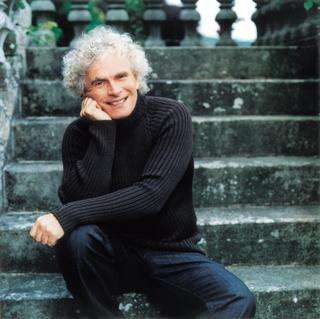|
Back
A Titanic Struggle Lucerne
Kultur- und Kongresscentrum Luzern
08/31/2010 -
Ludwig van Beethoven: Symphony No. 4 op. 60
Gustav Mahler: Symphony No. 1
Berlin Philharmonic Orchestra, Simon Rattle (conductor) 
S. Rattle (© Simon Fowler)
Mahler Festivals are nothing new. Mahler’s death 100 years ago next year gives rise to yet more Mahler cycles round the world and the Berliners under Simon Rattle are no exception. Rattle starts his cycle appropriately with the First Symphony. A chance, one hopes, to appreciate these symphonies afresh.
Rattle chose to preface the Mahler with Beethoven’s 4th Symphony. Whilst the brilliance of the Third and Fifth symphonies inevitably tends to eclipse the Fourth Rattle showed that the work has many subtler merits.
Rattle clearly enjoyed the jabbing dissonances that build up in the slow introduction before the rousing Allegro vivace, the Berliners’ strings being exceptionally fleet-footed, the woodwind at all times full of character and individuality. Rattle revelled in the work’s rhythmic and dynamic contrasts, exaggerating them wherever possible. But by the end of work I was wondering whether it was not all too elegant and suave, a hallmark of this orchestra which does suit many works, and left me hankering for a touch of Norrington and some period instruments.
The final movement, with its dazzling perpetual motion Allegro, ma non troppo had the woodwind in particular showing off their skills, the creamy bassoon, the mellow oboe, the chirpy clarinet, seamlessly interchanging so one sometimes had to look twice to see which was playing.
The similarities between Mahler’s First and Beethoven’s Fourth soon became evident, for example the emptiness at the start of both works before the works spring to life. Rattle was especially delicate in the opening passages of the Mahler, with long periods of suspense, before unleashing the fury at the end of the movement, revealing the full extent and virtuosity of this magnificent orchestra.
Rattle drove the second movement hard with considerable swagger, Kräftig bewegt, doch nicht zu schnell(forceful, but too not fast), pausing for the sweet elegance of the Trio. The principal double bass playing the opening of the “Frère Jacques” theme in the third movement was incredibly accurate and refined and rightly attracted special applause at the end. Rattle treated the central serene section with due reverence.
In the second half of the concert, I had changed my seat from the Stalls to the Choir for the Mahler so could witness Rattle’s facial gestures, which extend from awe to what looks like great pain, making him look at times quite demonic. The final energy storm in the last movement came after a terrifying build-up, with whooping brass, before its ecstatic final outburst.
Rattle was clearly pleased with this undoubtedly fine, clearly thought-out performance even though the final movement contained a surprising number of technical faults and even an early entry by the percussion, which took Rattle visibly by surprise.
John Rhodes
|